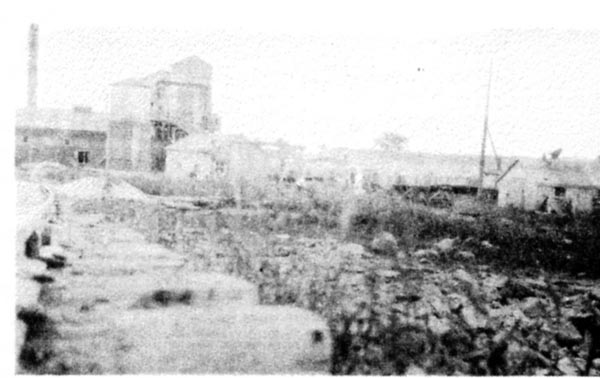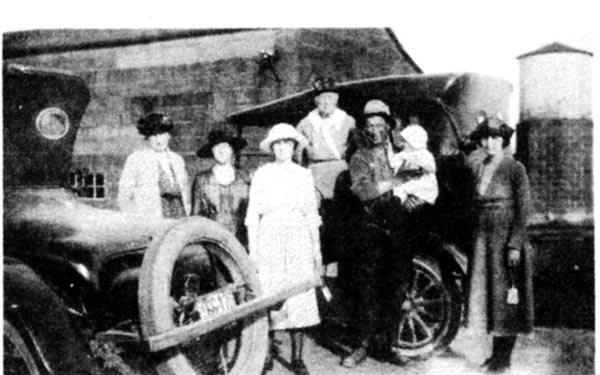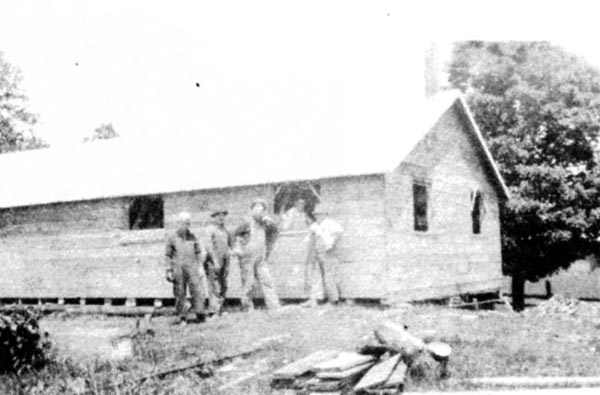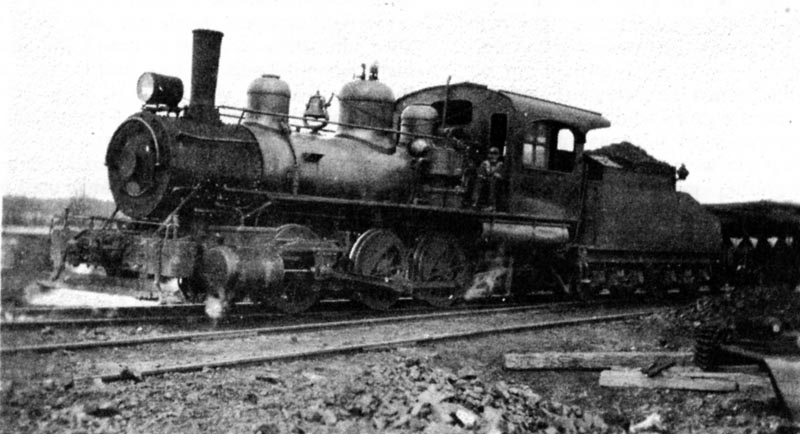The Railways of Ottawa
Findings of the Circle - Number 29

Dominion Construction Company and Grenville Crushed Rock
Operations at Deeks
| The following two
articles are taken from "Around the Township", a publication by
Oxford-on-Rideau Township as a bi-centennial project in 1984. For
additional information about the locomotives used at Deeks, see the
article by Colin Churcher in Branchline, January 2009. Deeks Information by Harold Bolton, W.J. Evans, Edison Hanlan The Rock Cut was scrub covered property belonging to Bill Anderson, of Oxford Mills, at the time. There were about 100 acres here and previously owned by three families. Fifteen acres, between the C.P.R. north to the concession road, was bought from Ed Hanlan, in order to set up the crushing plant and railyard. Later, another 8½ acres north of the township road, was bought from the rear of the Evans farm for more rock. About 40 acres of the surface area had rock removed Work began in 1919 but the crusher did not operate that year. The best year was in 1926, when 2,700,000 tons of crushed rock was taken out and crushed for ballast. 1933 was the last year they crushed. After that time rock was crushed and stockpiled and the seasons were short. At least 120 men worked there in opening operations but during Depression there were less. One summer when they were balancing the track, nearly 200 men were working. The camp whistle blew at 7:00 a.m., 12 noon, and 5:00 p.m. and could be heard for miles around. Men worked twelve hour shifts, beginning at 7:00 a.m. Wages were 40 50¢ an hour while a man and team received 80¢ an hour. Teams were required to draw the drills to the on location blacksmith shop for sharpening and return them to the drill location by night and also to draw the dynamite. The biggest blast set off at one time was two tons of dynamite. At one time there were seven crushers in a row and the biggest shovel carried four yards of gravel. The big hill deposit was owned by the C.P.R. and the face of the rock was 30-32 feet deep and at one time they crushed right to the tracks and rocks were falling on the rail line. After that they moved but the north wall was not as deep as the south side. Groceries came in by train, from Grenville Crushed Rock Ltd. was the rock crushing and ballasting division of Dominion Construction Company. H.F. McLean, co-owner of the companies, was born in Many local men worked here, some of them being -Jimmy Rintoul a secondary operator on the power shovel and rode the boom-cat; crusher men were Harry Hayward, Milton Ross, Steve Heaphy; electricians were Walter Copping and Don Dougall; mechanic - Earl Sears; Sammy Dillabough a trainman; Willie Dillabough and Cliff Evans were brakemen; all six members of the Evans family worked here - Mr. Evans Sr. drove the team and Billy succeeded him after his death, Clifford, Clarence, Jert and Roy; Jack White carpenter and Albert White , security. Others who worked were Delore Montroy, David and John Forbes, Jack Derrick, Dominic Sauve, Zach Bolton, Billy Mews, George Hobson, Fred Hillis, Eldon Flood and George Hyland. Charles Switzer was chief accountant and Bill Lafaver the blacksmith. When the crushing job was completed in 1932 a bronze casted plate was made in the shop before they moved. In World War II, 1940-1942, Deeks was reopened and used as a depot for war supplies. About 33 to 35 men worked at this time. There were fourteen spur lines running through the cut and a train could be loaded and in Since
that time
Deeks has been completely closed down. |
 |
 |
 |
 |
 There are no captions to these
pictures
Plant Operations At Deeks by Earl
Sears
My first recollection of Harry F. McLean's work at Deeks was in 1921 and they were building bunk houses and a plant or plant extension The entire plant was powered from the boiler room on steam. Steam and steam engines furnished the power that operated the crushers and everything that was used in connection with the grading process that took place in the manufacturing of crushed rock. The company was called Grenville Crushed Rock Co. and they produced the rock ballast which was used on the C.P.R. line between The blast holes were laid out by our civil engineer. As I remember the blast hole drilling pattern was eight feet apart. The holes were drilled by a machine similar to our present day well drill. A rope was used to hoist the drill column and the walking beam that made the drill stem churn up and down, was a crank with a pulley at the end of it, the flanges of which, came astride of this drill rope operated by a crank. As the machine turned throught its revolution, it gave the churning action necessary to produce the rise and fall of the drill stem. The drill stem must fall freely to produce a blow which chipped away the rock little by little. The drill stem and drill bit weighed, probably, upwards to one-half ton. The drill bit was 5 5/8" in diameter. A good drill operator earned about $10.50 a day plus .35¢ per foot. There was also some sort of a premium arrangement which gave the drill operator an incentive to work harder and produce more footage, so that as soon as one hole was drilled they moved rapidly to begin drilling again. The same was true with the loading of crushed rock into the cars that hauled it from the quarry pit to the crushing plant. The shovel operators were paid about $400.00 per month plus their sustenance which was board and lodging at the plant. In addition they received the premium rate over and above a normal days work. Explosives were used to break or shatter the rock after it had been drilled and received the dynamite charge. These were tremendously massive sticks of explosives, measuring 4" in diameter by 16" in length. They resembled an armful of wood when they came out of the dynamite boxes. They were carried to the drill holes where they were tapped into the holes and sand tamped on top of the hole. This was wired to a dynamite cap set in the explosive itself. They used to blast about 30 holes at a time and when the blast was fired, everything went BOOM! It was like a small earthquake and could be felt for a radius of about two miles. Next came the grading of the rock. This was done by means of screens. We sold various sizes of crushed rock - the heaviest was 2½ - 3" in diameter of rough nodules of rock. We had coarse grades and fine grades -the finest was ¾" in diameter. The top layer of rock ballast was about 1½" in diameter, just the right size for tamping under the railroad ties. The crushing plant was a very dusty place because the rock was sandstone. Sandstone gives off a very white powder almost like talcum powder. In the beginning the plant was powered by steam but only until Hydro Electric power became available. Then the plant had to be converted from steam engine drives to electric motor drives. The transaction was quite interesting because they must dispose of all the big pulleys that had driven the rock crushers by means of a flat leather belt between a drive shaft and driven shaft. These rock crushers required 300-400 horsepower to turn the motors after a load of rock had been dumped on top of them. When the plant was converted we did not have the present day V-belts so ropes were used. They were 16 to 24 ropes in width and the pulleys were grooved to accommodate them. Each had to be spliced by a man who was highly skilled and extremely adept at working with cordage. The rope drive was probably 25 feet between the pulleys of these heavy machines, so each rope must be exactly the correct length. V-belts did become available and we were able to abandon the rope belts in 1930. The V-belts were very strong and lasted for many years. But they were extremely dangerous as people could get their clothing caught in them. As my job was maintenance, we were called upon to produce guards for all the V-belts used in the plant. Let us look at the transporting of the raw material from the quarry pit to the rock crushers. Grenville Crushed Rock used a series of saddleback locomotives. They were small locomotives, a one man unit - the man who was engineer was also fireman and brakeman. He hauled 3 small cars which held about three cubic yards of rock or four power shovel scoops. When the train was loaded, the engineer tooted the whistle and drove the train backwards to the crushing plant. This was level track until he came to the base of the incline at the crushing plant. Here they uncoupled the cars one at a time and a donkey engine hauled the cars, one at a time, up the incline. Then it got dumped into the primary crusher. The empty car came back down the incline and was switched on to another track. This procedure was repeated for each car. Meantime the man who drove the saddleback engine was switching the engine over to the tracks on which they were putting the empty cars. When they got three cars emptied, he latched on to them and went back to the loading zone again. This operation continued all day. A man at the base of the incline had a board on which he kept track of the number of loads of rock that came up the incline. This had to tally with the power shovel operators score. On the other side of the plant were the bin chutes from which the crushed rock came out into the railway cars. From there it was hauled up the mainline and dumped on to the tracks in the form of rock ballast. These rock cars held about sixty-five tons each and were handled by yard engines. These engines were full scale locomotives usually classified as yard engines and used for shunting cars in railway yards at divisional points. When we got a trainload of rock it was of considerable weight and value. All the equipment that we had was serviced on the premises by the machine shop, the boiler shop, the forge shop and the welding shop. In 1926, when I arrived at Deeks, I already was a technical school graduate but I came under the jurisdiction of the machinist, the boiler maker, the forge smith and the chief welder. I had to learn all those skills in order to become a competent person who could produce good sound overhaul jobs on any piece of equipment that our plant needed or used in the process of production. It was an extremely interesting season, beginning in early April and running to the end of November. Then we would go through each of these units and examine every part so that when we took it out in the spring, we were sure, it was ready for use for the entire season. Rock crushing was a rough operation It has been a pleasure to renumerate the many processes at our old plant at Deeks and I'm very happy to have been able to do it for what it is worth, in a historical sense, in this area, at this late date. I am now seventy-seven years of age and my days in industry have long since passed me by. Thank you.  Article by Addy Schwalm in Branchline August/september 1982, page 10 Harry McLean's Quarry An interesting thing I saw in CP Rail News for May 20 was a story on Harry McLean's quarry that was once near Merrickville. My interest started around 1948 or 1949 when through my ad in the old "Railroad Magazine" I met two Ottawa high school students who at that time were interested in railroading. One of them by the name of Arnold Millar was able to get his father's car on a Saturday and four of us went to this quarry, which at that time had a spur running off the main line. A sign board near the switch stand said "Deeks". I believe this quarry was a very large hole in the ground, so big in area it held a small yard. As I remember, it held four tracks, two of them with high sided dump cars. Another had a string of construction cars, and the last, passenger cars, all pretty well dilapidated with paint peeling, boards loose, and wheels and draft gear well rusted. However, his private car and another one were in pretty good shape. In fact, I took an interior shot of the car with the crew sitting in wicker easy chairs. It was equipped with a stove, dining room and sleeper bunks. The real interesting part, though, was another track which held two 0-6-0's in very good shape, I was sorry later that I failed to take pictures of the two huge steam shovels that were standing separately on their own short stretch of track. Also standing by themselves were two little Porter 0-4-0's. They were narrow gauge and as you can image pretty well gone but I got their pictures as well. The last I heard of this equipment was that it all went for scrap. I doubt if I could find the spot again for it has all been overgrown in trees and shrubs. When we first went in the road was just a trail but now there is a little bettor gravel road. I never went back, but I do go near the place quite often. |